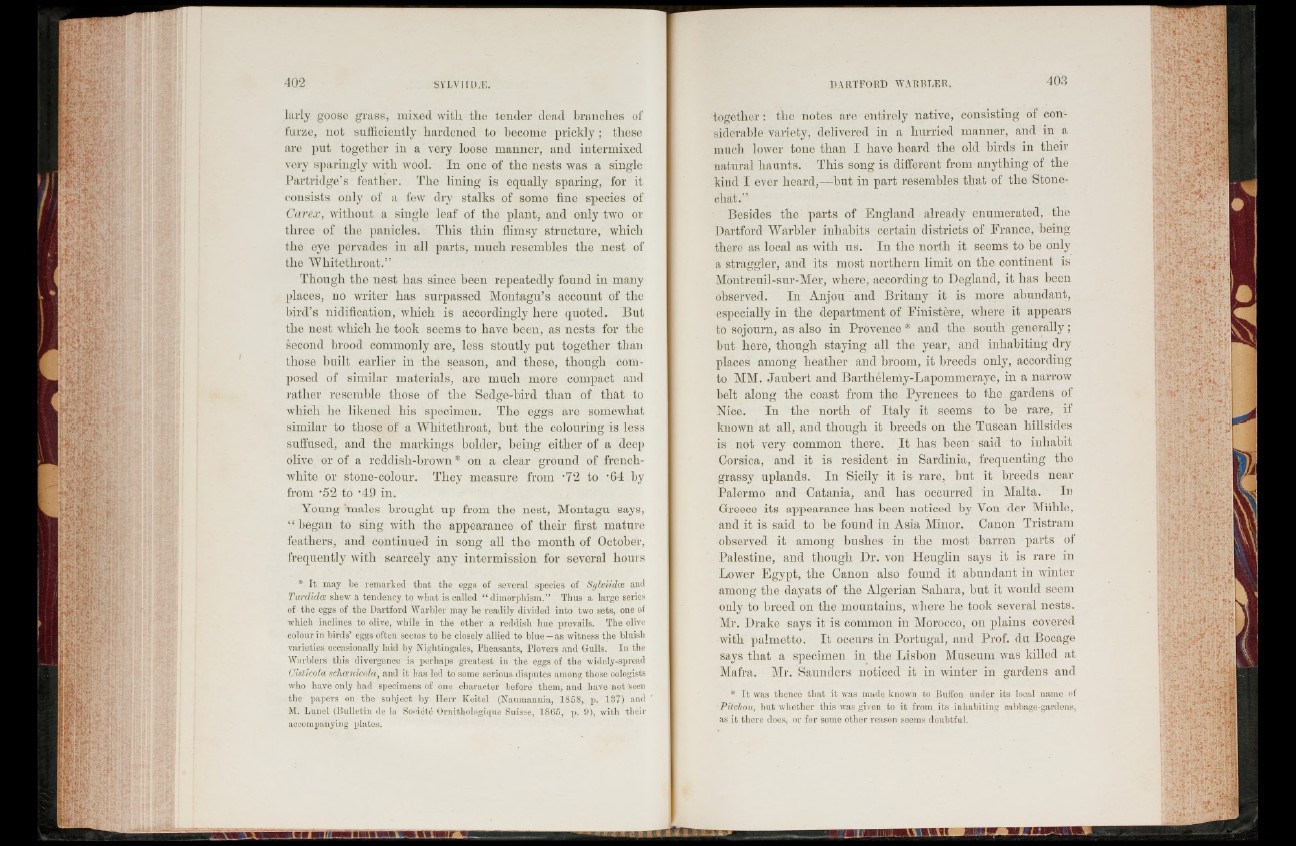
larly goose grass, mixed with the tender dead branches of
furze, not sufficiently hardened to become prickly ; these
are put together in a very loose manner, and intermixed
very sparingly with wool. In one of the nests was a single
Partridge’s feather. The lining is equally sparing, for it
consists only of a few dry stalks of some fine species of
Carex, without a single leaf of the plant, and only two or
three of the panicles. This thin flimsy structure, which
the eye pervades in all parts, much resembles the nest of
the Whitethroat.”
Though the nest has since been repeatedly found in many
places, no writer has surpassed Montagu’s account of the
bird’s nidification, which is accordingly here quoted. But
the nest which he took seems to have been, as nests for the
second brood commonly are, less stoutly put together than
those built earlier in the season, and these, though composed
of similar materials, are much more compact and
rather resemble those of the Sedge-bird than of that to
which he likened his specimen. The eggs are somewhat
similar to those of a Wliitetliroat, but the colouring is less
suffused, and the markings bolder, being either of a deep
olive or of a reddish-brown * on a clear ground of frencli-
wliite or stone-colour. They measure from -72 to -G4 by
from -5‘2 to ‘49 in.
Young males brought up from the nest, Montagu says,
“ began to sing with the appearance of their first mature
feathers, and continued in song all the month of October,
frequently with scarcely any intermission for several hours
* I t may te remarked tliat the eggs of several species of Sylviidce and
Vurdidce shew a tendency to what is called “ dimorphism.” Thus a large series
of the eggs of the Dartford Warbler may be readily divided into two sets, one of
which inclines to olive, while in the other a reddish hue prevails. The olive
colour in birds’ eggs often seems to be closely allied to blue —as witness the bluish
varieties occasionally laid by Nightingales, Pheasants, Plovers and Gulls. In the
Warblers this divergence is perhaps greatest in the eggs of the widely-spread
Cisticola schoenicola, and it has led to some serious disputes among those oologists
who have only had specimens of one character before them, and have not Seen
the papers on the subject by Herr Keitel (Naumannia, 1858, p. 137) and
M. Lunel (Bulletin de la Société Ornithologique Suisse, 1805, p. 9), with their
accompanying plates.
together : the notes are entirely native, consisting of considerable
variety, delivered in a hurried manner, and in a
much lower tone than I have heard the old birds in their
natural haunts. This song is different from anything of the
kind I ever heard,—but in part resembles that of the Stone-
cliat.'’
Besides the parts of England already enumerated, the
Dartford Warbler inhabits certain districts of France, being
there as local as with us. In the north it seems to he only
a straggler, and its most northern limit on the continent is
Montreuil-sur-Mer, where, according to Degland, it has been
observed. In Anjou and Britany it is more abundant,
especially in the department of Finistère, where it appears
to sojourn, as also in Provence * and the south generally ;
but here, though staying all the year, and inhabiting dry
places among heather and broom, it breeds only, according
to MM. Jaubert and Barthélemy-Lapommeraye, in a narrow
belt along the coast from the Pyrenees to the gardens of
Nice. In the north of Italy it seems to he rare, if
known at all, and though it breeds on the Tuscan hillsides
is not very common there. I t has been said to inhabit
Corsica, and it is resident- in Sardinia, frequenting the
grassy uplands. In Sicily it is rare, but it breeds near
Palermo and Catania, and has occurred in Malta. In
Greece its appearance has been noticed by Yon der Mühle,
and it is said to he found in Asia Minor. Canon Tristram
observed it among hushes in the most barren parts of
Palestine, and though Dr. von Heuglin says it is rare in
Lower Egypt, the Canon also found it abundant in winter
among the dayats of the Algerian Sahara, hut it Would seem
only to breed on the mountains, where he took several nests.
Mr. Drake says it is common in Morocco, on plains covered
with palmetto. I t occurs in Portugal, and Prof. du Bocage
says that a specimen in the Lisbon Museum was killed at
Mafra. Mr. Saunders noticed it in winter in gardens and
* I t was thence that it was made known to Buffon under its local name of
Pitchou, but whether this was given to it from its inhabiting cabbage-gardens,
as it there does, or for some other reason seems doubtful.